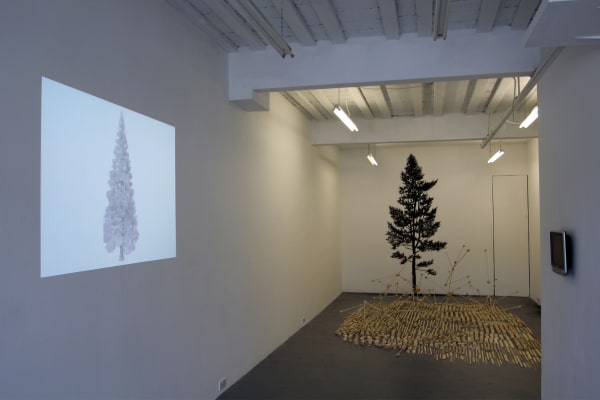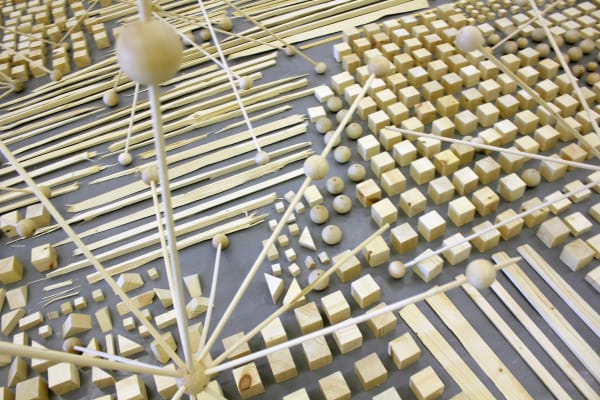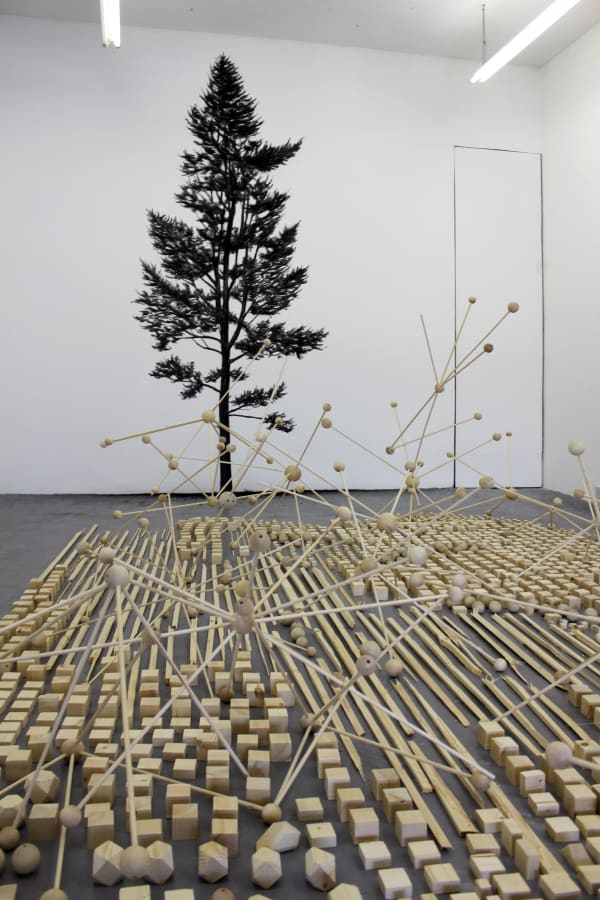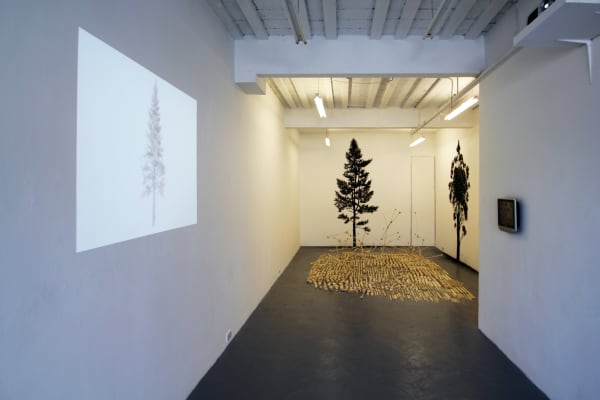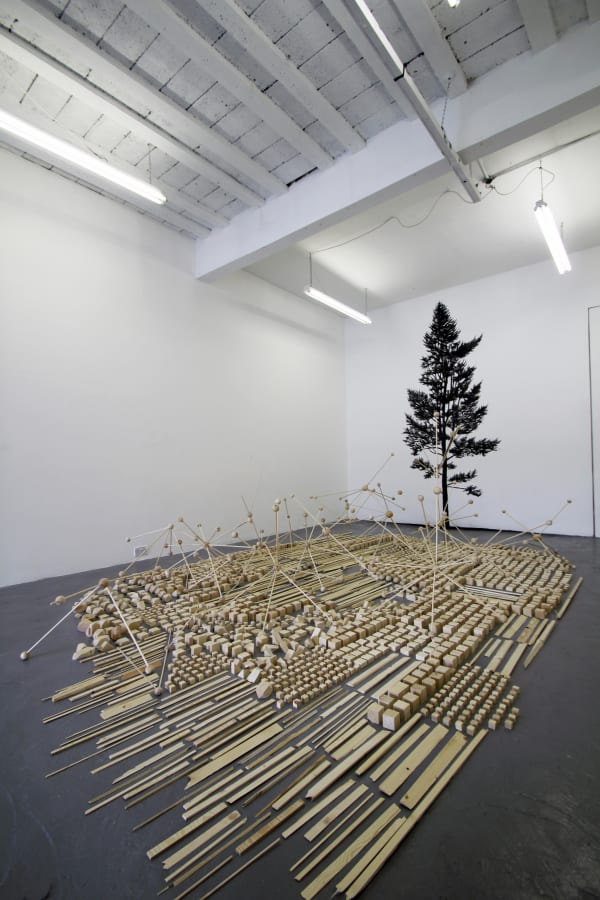In all things: 126 Gallery, Galway, Ireland
For his most recent exhibition artist Eamon O´Kane has chosen to focus on the chemical element Carbon. O´Kane has produced a series of charcoal animations and constructed a site-specific installation of new charcoal wall drawings and sculptures examining the molecular and crystal structure of carbon and other elements.
Review
In all things
Eamon O'Kane
126 Gallery
June 13th - July 7th 2012
PUBLISHED in The Visual Artists News Sheet (VAN) Issue 3 2012
Review by Áine Phillips 24th June 2012
Monumental coniferous trees are rendered directly on the wall of 126 in charcoal, the material produced from their own burnt and compressed bodies. The black carbon coats the wall with velvety flocking, its ashy black dust litters the floor, forming a sort of compost out of which an installation of machine tooled wooden blocks, sticks, strips of torn wood and molecular geometries rise like rhizomic growths from the underground of Galway’s artist run gallery. Eamon O’Kane has created a space of darkly observed beguilement and play using his characteristically diverse means: in wall drawings, sculptural installation, projected and screened stop motion animations; all arranged in the space with bold clarity and simplicity.
This accessibility is also reflected in his well articulated artist statement outlining his research on the chemical element carbon which is found ‘In all things’ of the show’s title. O’Kane’s multiform conceptual connections link Frederich Fröbel’s (the inventor of the Kindergarten) educational play blocks, the development of creativity with botany, crystallography, explorations of carbon in forms and processes of material assemblage.
Carbon, O’Kane points out, is a most abundant element and the basis for all known life. He materially represents its properties through wood as a live body (in his tree images), a mutilated body (in his installation of dissected wooden parts) and a cremated body (through charcoal). He then renders its regeneration and resurrection via three charcoal drawn animations that display different modes of wooden re-construction. The first is a screen full of wood blocks transforming into crystalline shapes. The second is a slowly compounding array of carbon molecules networking into a dense impenetrable web. The third is a vigorous sequence of various coniferous and deciduous tree drawings, each appearing rapidly in the projection like subliminal messaging urgently communicating their ecological authority.
O’Kane provides no titles on any of his works, which makes the show a little difficult to navigate (or refer to in this review). I am informed by 126 that his intention is to open the work to buoyant and unconstrained interpretations. In his commercial shows, labels are requisite, but he emancipates his work from titling for alternative spaces. Exhibiting internationally, producing multiple solo shows a year, O’Kane is prolific both in output and range of practice. What does this artist not do? His works often explore different aesthetic styles and methodologies appropriated from other disciplines such as science or architecture. I am reminded of Canadian artist Rodney Graham whose work shares many of O’Kanes concerns and varied aesthetic approach. They both express an intense commitment to rigorous intellectual art, enjoy visual puns and absurdist humor while examining social and philosophical systems of thought, particularly modernism. In Graham’s film works the artist performs his own ingenious characterizations, to my knowledge the only art form O’Kane has yet to try!
O’Kane also cites his young family as stimulus for his practice, an aspiration most artistic parents dream of. “My sons Emil and Mikkel were born in 2005 and 2007. They provide a constant flow of joy and inspiration, and continually prove that play is at the root of all creativity.”1 There is a delight in creativity and unselfconscious imaginative leaps evident in his practice that suggest O’Kane enjoyed and respected the act of ‘play’ in his studio long before the arrival of his children. In art, play as a methodology is most useful when married with conceptual coherence and O”Kane also incorporates lively artistic references to add further depth and interest to his work. ‘In all things’ channels at times the cool abstraction next to psychological figuration of Isabel Nolan, the modernist architectural designs of Buckminster Fuller or Le Corbusier and William Kentridge in the scratchy, dense emergence and accumulations of images in his animated drawings.
Eamon O’Kane has created an imaginative space of play, intellect and beauty in this exhibition that attempts to address ‘life the universe and everything’ in its scope. It is simple and direct on many levels, accessible to a broad public with a complex underbelly of reference and meaning to satisfy even the most exacting art critic.
Footnotes:
1 Quote taken from an online article on Eamon O’Kane’s work. http://www.hermanmiller.com/lifework/ideal-livework-space-artist-eamon-okane/





